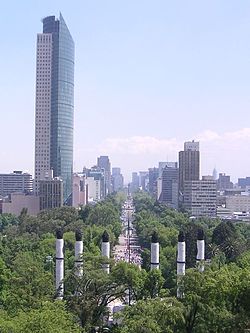Chapultepec
Chapultepec (Chapoltepēc = "at the grasshopper hill" in the Nahuatl language) is a large hill on the outskirts of central Mexico City with much significance in Mexican history. In modern Mexico City Chapultepec Park, consisting of the hill and surrounding land of 1,600 acres (6 km²), has many attractions.
History

Ritual and domestic objects including funerary urns in the Teotihuacan style from about the 4th century have been discovered by archeologists on Chapultepec.
The last Emperor of the Toltecs, Huemac was said to have spent his last days in a cave at Chapultepec after the fall of Tula.
In the days when Tenochtitlán was the island capital of the Aztecs, the city was linked to Chapultepec by a causeway and the hill was a retreat for the Emperors. A sculpture of Moctezuma I can still be seen (in unfortunately damaged condition) carved into the rock of Chapultepec, not far from Huemac's cave.
During the Spanish colonial era, the Viceroys of New Spain had their palace atop Chapultepec, demolishing Pre-Columbian structures in the process. A larger Viceregal castle was constructed on the spot in 1784.
After Mexico won its independence, the old viceregal palace was turned into a military academy in 1833. During the Mexican American War a group of young teenaged cadets fought to their deaths against the invading United States Army here; they are today remembered as Mexico's Niños Héroes – the "Boy Heroes" or "Heroic Cadets (see: Battle of Chapultepec).
When Napoleon III launched the French intervention in Mexico and imposed a monarchy in the 1860s, Emperor Maximilian of Mexico and Empress Carlota of Mexico set up their residence in the existing Castillo de Chapultepec atop Chapultepec Hill, expanding the Spanish colonial structure.
Chapultepec Park Today

The hill of Chapultepec and surrounding land are now Chapultepec Park, a popular spot both for locals and tourists. Chapultepec is at one end of Paseo de la Reforma.
The park covers 1,600 acres (6 km²) of land, centuries old forest, several small lakes, and landscaped areas with out-door cafes. Chapultepec Zoo is located here, as well as an amusement park, La Feria.
Chapultepec Castle atop the hill is the National Museum of History. The park also includes the National Auditorium, lots of other museums, including the Modern Art Museum, the Tamayo Contemporary Art Museum, the Natural history Museum, the Papalote Children's Museum and the large National Museum of Anthropology and History with perhaps the world's finest collection of Pre-Columbian Mesoamerican art and artifacts.


See also
External links
- [1] Page with several articles from the Arqueología Mexicana journal about Chapultepec. In Spanish
- Satellite picture by Google Maps
